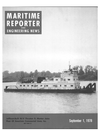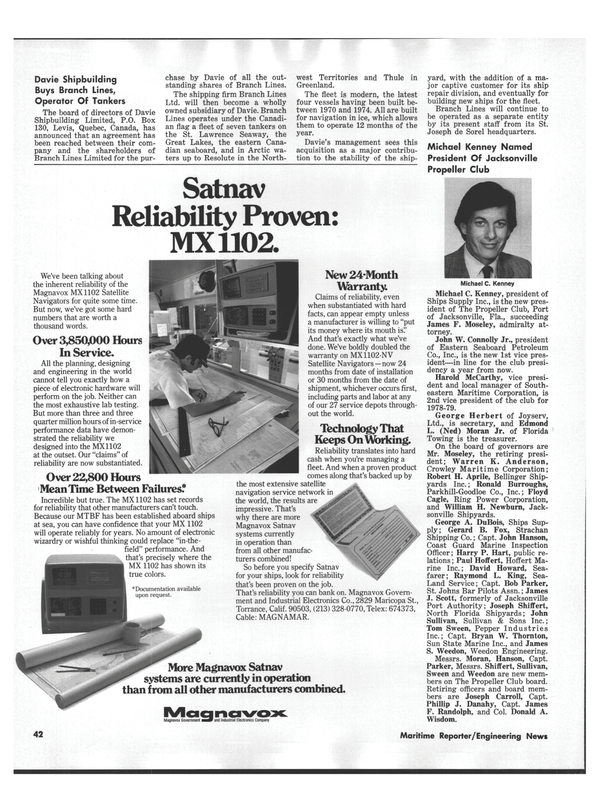
Australian Designs Fast 1,600-Ton Containership With Crew Of Only Five
An Australian naval architect has designed a fast, short-haul containership of nearly 1,600 tons which has a crew of only five men.
He is Warwick Hood of Sydney, who said the ship, equipped with the latest technological aids, could be managed by a crew of only two.
Mr. Hood said there was nothing revolutionary about the equipment.
"All t h e i n g r e d i e n t s we have used are readily available.
Only the recipe is new." Mr. Hood, a designer of racing yachts including Australia's 1967 America's Cup challenger Dame Pattie, was commissioned to design a vessel for a fast service covering 200 miles across Bass Strait between the mainland and the Australian island State of Tasmania.
With the design completed and a model tank-tested, negotiations are now going on for construction of two of the 308-foot ships at a cost of about $A6,000,000 each.
Each carrying 74 c o n t a i n e r s stacked two-high on deck and no cargo below deck, they would operate daily round trips between terminals.
With twin lightweight diesel engines providing a speed of 22 knots, they would make two ninehour crossings with two hours at each end for loading and unloading, servicing, refuelling and crew change, and a one-hour margin "for the unexpected." "With the planned level of automation, all functions could be handled with a crew of five — a master, two navigation officers and two engineering officers," Mr.
Hood said.
"The ship will be controlled entirely from the air-conditioned wheelhouse where ergonomically laid-out controls such as radar, compasses and machinery surveillance systems will give the crew virtually an armchair ride.
"There will be no one in the automated engine room. There will be no seamen because their traditional functions have been eliminated or replaced by automatic or remote-controlled devices.
"For example, there are no ropes to tie, there is no cargohandling gear on the ship, and there are no hatch covers because the containers are all on deck. The containers don't need to be lashed down because they fit into a fullheight cell guide structure built on the deck." A mooring arrangement has been developed whereby hydraulic arms controlled from the wharf would link the ship to the wharf in a precise location. Container cranes could be positioned to begin immediate unloading.
"This type of operation can only operate successfully between two purpose-built terminals with mooring facilities and cranes organized specifically for the ship," Mr. Hood said.
The ship would be equipped with a wide array of technological aids, including satellite navigation equipment, situation display radar, weather facsimile receiver to print out instant weather maps, automatic pilot and equipment to operate and monitor all engineroom functions.
Normally, a ship of this size would carry about 16 crew.
In the accommodation area would be rest rooms with beds, television lounge and an aircrafttype galley stocked with prepared meals at each port.
"A lot of people said we were doing something revolutionary, which made me angry, and there was a lot of resistance to the project on that basis," Mr. Hood said.
"It is unusual in a number of respects, but there is nothing new in the level of technology used to achieve it. What we are aiming for is a very professional kind of seagoing operation." For additional information, contact Geoff Dixon, Australian Information Service, 636 Fifth Avenue, New York, N.Y. 10020.
Read Australian Designs Fast 1,600-Ton Containership With Crew Of Only Five in Pdf, Flash or Html5 edition of September 1978 Maritime Reporter
Other stories from September 1978 issue
Content
- Marine Engineering Firm Formed In Oregon page: 4
- Jurong Shipyard Ltd. Awarded Multimillion Conversion Contract page: 4
- Data Sheet Describes Shipboard Interior Fireproof Panels page: 4
- Jeffboat Delivers The Thruston B. Morton page: 6
- Bell Aerospace Delivers 160-Ton Air Cushion Landing Craft To Navy page: 6
- Avondale To Construct Two Multi-Product Ships For Ogden Marine page: 6
- Orion Gautreaux Named Zapata Vice President page: 6
- Rhine-Schelde-Verolme And IHC Offshore Yard Effect Shipbuilding Merger page: 7
- APL To Build Five New Containerships page: 8
- Kongsberg Systems, Inc. Names Ambjor President page: 8
- Eagle Dredging Awards $25-Million Contract To Avondale Shipyards, Inc. page: 8
- Newfoundland Headed For Major Economic Advances In 1980s page: 9
- Tracor Marine Awarded $3.6-Million Navy Contract page: 10
- Sheridan Lee Opens New York Office page: 10
- ALRC Gets $13-Million Award To Supply Pumps For Boeing-Built Ships page: 10
- W.E. Christiansen Jr. Joins St. Louis Ship page: 10
- PSI Completes Total Package Concept With Todd 'Apache' Contract page: 12
- Third Generation Ro/Ro Subject Of New York SNAME Section Meeting page: 14
- John Smith Named Yard Operations Director At NASSCO page: 14
- MarAd Study Examines Shipping Policy Options page: 14
- Three-Day Maritime Safety Meeting Set For Chicago October 2-4 page: 15
- Cargo Security Study Sponsored By Government page: 16
- Todd Pacific Shipyards Launches Guided Missile Frigate Wadsworth (FFG-9) page: 16
- J. Ray McDermott & Co., Inc. Delivers 126-Foot Tug To Louisiana Tugs Company page: 16
- First Crab Boat Built By Halter Marine, The 150-Foot Alaskan Enterprise, To Operate In Bering Sea For Francis Miller page: 16
- Agri-Trans Names Miller Director Gulf Operations page: 17
- Robert Hague Post Honors James A. Farrell Jr. page: 18
- Boeing Awards Six Hydrofoil Contracts Totaling $4,360,000 page: 18
- Hongkong United Dockyards Ltd. (HUD) Forms New Subsidiary page: 18
- NKK Signs Agreement With Baker Marine Corp. page: 20
- Women Invade Engineers' Seagoing Dredge Fleet page: 20
- Uniflite Awarded $3.2-Million Navy Contracts For Target Boats page: 22
- Technical Report On Mooring For LNG Ships Released By MarAd page: 22
- Port Electric Named Marine Distributor By Jeamar Winches Ltd. page: 22
- Perry Oceanographies Designs And Builds New Undersea Work System page: 23
- 'Ocean Trade And Transport Of Phosphate Rock7 page: 24
- Samson And SMATCO Join To Expand Traction Winch Market page: 24
- Captain Tom Smith Forms CTS And Associates page: 24
- Charles Lehman Elected ACBL Vice President page: 24
- Swann Oil Relocates New York Office page: 24
- IMODCO Receives Third Contract From PEMEX In Two-Month Period page: 24
- Salen & Wicander Opens Office In United States page: 25
- Zapata Corporation Announces Senior Management Promotions page: 25
- J. Leslie Goodier Joins Battelle In Marine Technology page: 26
- Charles G. Kiskaddon Named President Alcoa Steamship page: 26
- James H. Sanborn Joins Interstate And Ocean Transport Company page: 26
- John J. McCarthy Joins Waukesha Engine Div. Dresser Industries, Inc. page: 27
- lotron Corporation Introduces Automatic RPM/Speed Converter page: 27
- Peoples' Republic Of China Concentrates On Building Up Bulk Carrier Fleet page: 28
- L. James Gardner Joins Bath Iron page: 29
- Castle & Cooke, Inc. Plans Purchase Of Seven Ships page: 29
- Halter Marine Announces Corporate Name Change page: 30
- Dravo SteelShip Names Frank C.A. van Bentem 30 Maritime Reporter/Engineering News Engineering Director page: 30
- Nominations Are Open For Shepheard Award For Maritime Safety page: 30
- Human Element In Ship Operation Is Subject Of Maine Maritime Seminar page: 30
- Halter Marine Adds Tenth Shipyard page: 30
- API Annual Tanker Conference To Be Held At Tarpon Springs Oct. 1-4 page: 32
- Paceco International Appoints Alan Holme Managing Director page: 32
- Cuba Takes Delivery Of Third Canadian-Built Ship page: 34
- Smit Nymegen Corporation Holds Seminars On Independently Fired Inert Gas Generators page: 34
- Raymond Subsidiary Awarded $10-Million Contract In Venezuela page: 36
- Port Everglades Foreign Trade Zone Expansion Approved page: 36
- Canadian Shipbuilding Production Summary For First Six Months page: 36
- Gulf Mississippi Adds Two Vessels To Fleet For Offshore Service page: 38
- Lennart Thorell Joins Todd Pacific Shipyards page: 38
- Marine Concrete Structures Delivers First 2 Platforms From New Dock Facility page: 38
- Halter Marine Delivers First Of Three Supply Boats To Brazil —First From U.S. Shipbuilder page: 40
- The 1,000-Foot M/V George A. Stinson Joins National Steel's Fleet Of Ore-Carrying Vessels page: 40
- Australian Designs Fast 1,600-Ton Containership With Crew Of Only Five page: 40
- Davie Shipbuilding Buys Branch Lines, Operator Of Tankers page: 42
- Michael Kenney Named President Of Jacksonville Propeller Club page: 42
- SNAME Gulf Central Section Told How A Load Line Assignment Is Obtained page: 43
- Repairing Vessels Since 1834, Camden Ship Repair Company Starts $4-Million Expansion page: 44
- API President Suggests That Oil Firms Should Participate In Solving U.S. Energy Dilemma page: 44
- ITT Decca Marine Forms New Marketing Services Department page: 45
- $4.5-Million Loan For Northern Metals Marine Terminal page: 46
- Robert Ivey Joins Mississippi Marine Towboat Corporation page: 46
- World And U.S. Bulk Shipping page: 46
- Bay Shipbuilding Delivers Bulk Carrier M / V Buffalo To American Steamship Company page: 47
- Navy Awards IMODCO Development Contract For Portable SPM page: 48
- Waukesha Engine Names Donald E. Bates To Sales Post in Kuwait page: 49
- APL Names Kenneth Passe Mgr. Offshore Operations page: 49
- The Effect Of The 1978 IMCO Tanker Safety And Pollution Prevention Conference On Ship Design And Operation page: 49
- James Sweat Joins Matzer Associates page: 49
- Offshore Logistics, Inc. Announces Earnings For The Year Ended June 30 page: 49
- Tokyo Marine Services Starts Trans-Pacific Drydock Tow page: 50
- Quaker Chemical Corporation Acquires Selby, Battersby— David Kollock Named President page: 50
- Maritime Transportation Research Board Names Five New Members page: 50
- Francis A. Martin And Ottaway, Inc. Name Norman Jensen Partner page: 50
- Francis W. Bauer Joins ORBA Corporation page: 51
- Largest Vertical Submerged Screw Pumps Successfully Tested At Delaval Turbine page: 52
- Jardine Plans To Restructure Oilfield Servicing—New Name Jardine Offshore Promet page: 52
- Sea-3, Inc. Names Two New Vice Presidents page: 53
- California SNAME Sections Announce Joint Meeting page: 56
- Offshore Floatel To Accommodate 600 Workers page: 58
- Biehl & Company Opens Tenth Office In Atlanta, Georgia page: 58
- Acadian Supply Files Amended Application For Towing Vessels page: 59
- Port Everglades Propeller Club Installs Officers page: 59
- Italian Government Honors Worthington Pump Chief Executive page: 60
- Overseas Shipholding Group Reports Increased Earnings page: 60
- MARCO 'Modularizes' U.S. Navy Oil-Spill Skimmers For Easy Transport By Aircraft And Truck page: 61


